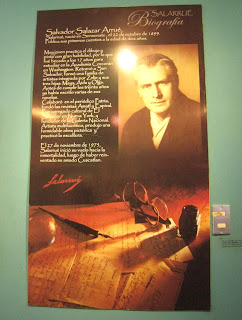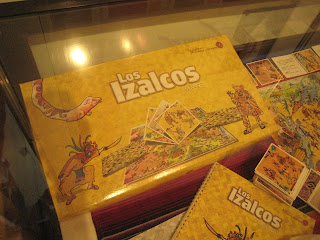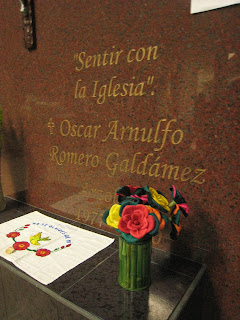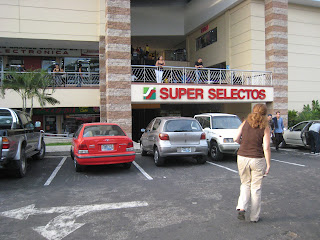Today was a very full and difficult day. We spent almost the whole day discussing the Salvadoran Civil War (1980-1992). We started the morning off with breakfast at Casa Antigua around 8am and Alfredo came to pick us up at 8:45am. By 9am we were in the microbus and ready to begin our Civil War tour of San Salvador. As we were driving along to our first destination we came upon people selling things in the streets. I saw someone selling mosquito zappers that electrify mosquitoes when you swat them. At one point I was demonstrating how to use it and accidentally zapped myself. Not a great start to the morning but it could have been worse.
Eating breakfast
Mosquito zapper
Divinia Providencia
The first place we went is called Divinia Providencia. I’ve been here before several times but still feel it’s important to write about the place and include a few pictures in my blog. Divinia Providencia is where Salvadoran Archbishop Oscar Romero lived and was martyred in 1980. We spent some time in the church where was he was killed and the little house where he lived. Here’s a bit of info about Romero:
Óscar Arnulfo Romero y Galdámez was born on August 15, 1917, to Santos Romero and Guadalupe de Jesus Galdámez in Ciudad Barrios. He was born into a very poor family in a dirt floor home. There was no running water or electricity and he slept on a mattress on the floor with his brothers and sisters. At age 12 he was apprenticed as a carpenter because he could not afford further schooling. At age 13 he began working to pay his way to seminary in San Miguel but was quickly promoted to seminary in San Salvador and finished his studies in Rome.
On April 4, 1942, Romero was ordained a Catholic priest in Rome. Romero remained in Italy to obtain a doctoral degree in theology which specialized in ascetical theology. In 1970 he was appointed auxiliary bishop to San Salvador Archbishop Luis Chávez, a move not welcomed by the more progressive members of the priesthood in El Salvador. On February 23, 1977, he was appointed Archbishop of San Salvador. His appointment was met with surprise, dismay, and even incredulity. While this appointment was welcomed by the government, many priests were disappointed, especially those openly aligning with Marxism. The Marxist priests feared that his conservative reputation would negatively affect liberation theology's commitment to the poor.
On March 12, 1977 a progressive Jesuit priest and personal friend of Romero, Rutilio Grande, who had been creating self-reliance groups among the poor campesinos (country people), was assassinated. His death had a profound impact on Romero who later stated, “When I looked at Rutilio lying there dead I thought, ‘If they have killed him for doing what he did, then I too have to walk the same path’.” In response to Father Rutilio’s murder, Romero revealed a radicalism that had not been evident earlier. He spoke out against poverty, social injustice, assassinations, and torture. As a result, Romero began to be noticed internationally.
In 1979, the Revolutionary Government Junta came to power amidst a wave of human rights abuses by paramilitary right-wing groups and the government. Romero criticized the United States for giving military aid to the new government and wrote to President Jimmy Carter in February 1980, warning that increased US military aid would “undoubtedly sharpen the injustice and the repression inflicted on the organized people, whose struggle has often been for their most basic human rights”. Carter, concerned that El Salvador would become “another Nicaragua” ignored Romero's pleas and continued military aid to the Salvadoran government.
On March 23, 1980, the day before his death, he gave a homily speaking directly to the soldiers. “Brothers, you are from the same people; you kill your fellow peasants… No soldier is obliged to obey an order that is contrary to the will of God… In the name of God, in the name of this suffering people, I ask you, I implore you, I command you in the name of God: stop the repression!”
Romero was assassinated on March 24, 1980 while celebrating Mass in San Salvador at a small chapel in Divinia Providencia. He was speaking about a parable just before he was shot: “Those who surrender to the service of the poor through love of Christ will live like the grain of wheat that dies… The harvest comes because of the grain that dies… We know that every effort to improve society, above all when society is so full of injustice and sin, is an effort that God blesses, that God wants, that God demands of us.”
According to an audio-recording of the Mass he was shot while elevating the chalice at the end of the Eucharistic rite. When he was shot his blood spilled over the altar along with the sacramental wine. The assassins were members of a military death squad. This view was supported in 1993 by an official U.N. report, which identified the man who ordered the killing as former Major and School of the Americas graduate Roberto D'Aubuisson. Romero is buried in the Metropolitan Cathedral of San Salvador. The funeral mass on March 30, 1980, in San Salvador was attended by more than 250,000 mourners from all over the world.
This is always a powerful story to hear, especially being at Divinia Providence and looking at the altar where he was martyred. Though I’ve heard it before it never gets easier to hear and I always see something or think about something new. After leaving the chapel we went to his small residence less than a block away which has been turned into a museum. Before entering the little museum we saw the small garden next to the house. It is said that after he was killed the nuns were afraid someone would steal his heart. So they secretly had it removed during the autopsy and put it in a bag. It was buried in the garden next to his residence. Several years later they dug it up and, supposedly, it was still red. This is one of the miracles attributed to Romero that has been shared with Vatican in hopes of making him a saint.
Inside the museum are all sorts of artifacts that belonged to Romero. They had the clothes and vestments that he was wearing when he was shot. You could see where they were stained with blood and the bullet hole that went into his chest. There were several photos taken right after he was shot and a newspaper printed the day after. Several of his personal possessions were in the museum such as toiletries, towels, more vestments, passport, and other items. We stayed for a while and then it was time to move on.
Divinia Providencia
The altar where Romero was martyred
The gate to his residence
Where his heart was buried
Painting now hanging inside his residence
Shirt he was wearing when he was killed
Robe he was wearing when he was shot
Photo taken just minutes after his death
Pope John Paul II praying at his tomb
Calendar from the year he was killed
Newspaper headlines
Romero's car
Testimonies of miracles that have
happened credited to Romero
A recent miracle
At 10:00am we left and headed to the University of Central American (UCA). I have also been to the UCA several times and have seen the chapel and museum there, but thinking about what happened there still makes me feel uneasy and upset. Here’s a little background info on what happened at the UCA:
On the night of November 16, 1989, a Salvadoran Army patrol entered the UCA in San Salvador and massacred six Jesuit priests, their housekeeper, and her daughter. The murders were committed because the Jesuits were voicing concerns over the atrocities of human rights violations being committed by the government during the war. They were all taken from their beds in the middle of the night. Some were killed in their rooms while others were dragged outside and killed. They were severely beaten before they were murdered. The death squads that killed these individuals and many other people were known for making an example out of people. They liked to kill and display people in the way that they were “committing offenses” against the government. The Jesuits used their mind and knowledge to speak out against what the Salvadoran government was doing. Thus, many of them had their brains torn out of their heads and spread over the ground.
We first went into the museum at the UCA about the martyrs of the Civil War. It had information about the Jesuit priests, the housekeeper and daughter, Romero, his friend Rutilio Grande, the American women and nuns that were killed, massacre sites, and the thousands of others who were killed during the war. They had blood spilled from the priests, Romero, and Rutilio Grande, which I always think is interesting. They certainly have a way of preserving things, even the bad things. They also had clothing the people were wearing when they died, maps, items that had been burned, and a book that was slashed by the people who murdered the priests.
Outside of the museum was a rose garden memorializing the people who were killed at the UCA. It was created by the housekeeper’s husband. Just around the corner from that was the room where the housekeeper, Elba, and her daughter, Celina, were killed. Inside one rooms of the UCA are several photo albums of the victim’s bodies and body parts taken the morning they were discovered. It’s never easy to look at the photos, but it helps us to better understand what life was like for ordinary people during the Civil War.
We usually go to the chapel next door after seeing the museum because there are several sketchings inside of people, bodies, and torture during the war. People keep these sketchings nearby because they want to remember the bad things so history does not repeat itself. Unfortunately, there was going to be a mass so my family was only able to take a quick peek before the mass started.
Hay que recordar para no repetir. One must remember in order not to repeat.
The UCA
Rutilio Grande photo and artifacts
Cross of the 6 Jesuit priests who were killed
Grass on which is blood from the priests
A dictionary slashed by the Salvadoran army
Photo of one of the rooms they burned
The American women who were killed
Painting hanging in the museum
Outside the housekeeper and her daughter's room
This is where the womens' bodies were found
Rose garden outside
Plaque in the rose garden
Equipo Maíz
Next we headed to one of the Equipo Maíz buildings. Equipo Maíz means “Corn Team” in Spanish. They are a group of women and men who make brochures and books and teach seminars and workshops on a variety of simple issues that affect the lives of the majority of people in El Salvador. The group has worked in El Salvador since 1983. They came about in the midst of war from a parish in the outskirts of San Salvador in order to assist the need of understanding what was happening during those years. Through the years they have maintained their two key themes of training and publication.
I specifically asked Kathy if we could go there because I wanted to get some books, posters, and maybe other things regarding social justice work, etc. It was only a quick stop but I had just enough time to get a few things. I bought two Romero shirts since I don’t have any. I also got a couple posters that I want to put in my room. And I bought one book that has photos of El Salvador and the people from 1900-1999. We loaded back into the microbus and were off again.
Equipo Maiz
Museo de la Palabra y la Imagen
Our next stop was the Museo de la Palabra y la Imagen (Museum of the Word and the Image). I had been here once before in 2007 but not since then. This innovative museum was founded in the early 1990s dedicated to collecting and preserving memories of the Salvadoran civil war, incorporating memories across the political spectrum. The general enthusiasm of the public quickly prompted the museum to expand and it now includes a variety of exhibits that deal with various moments in the nation's past.
The museum exhibits are constantly changing and today there was a lot of information about a Salvadoran man named Salvador Salazar Arrué who is known as Salarrué. He was born in 1899 and died in 1975. He is known for his novels, stories, paintings, and sculptures. We spent a little time walking through the museum. One of the books that he’d wrote which was on display in the museum I had just seen for sale at Equipo Maíz. It was fun to learn about someone I’d not heard of before. We spent a while walking through the museum looking around at books and paintings by Salarrué. Also inside the museum was a little bit of info on the Civil War. Many of the things I recognized from the museum in Perquin but here we were able to take pictures.
Museum of the Word and the Image
Poster about Salarrue
One of his books about
stories for kids
A game he created about the indigenous people
Painting by Salarrue
Another painting
Shield used by the army during the war
Poster created during the war
Salvadoran army badge
Guerilla (FMLN) badge
Photo taken during the war
Artisan Shops
Soon it was time for lunch. We stopped where we always stop with delegations: the artisan shops. They have a great little place for lunch and then we had time to do some shopping afterwards. Kathy and I bought things for Compañeros to sell at the Latino Festival this fall as my parents and Matt wandered in and out of shops. I also took a little time to do some looking of my own. I bought a pen with a torogoz on it, a big painted cross, and an avocado sorpresa. There are so many beautiful things that it’s hard to resist the urge to go crazy. But I didn’t go too nuts. Plus I got to help buy things for Compañeros so that was fun.
El Salvador del Mundo statue in San Salvador
Passing by the famous statue
Eating lunch
National Cathedral
We continued on after lunch and shopping to the National Cathedral. We went there not only to see the Cathedral itself but to see Romero’s tomb inside. Here’s a bit of info about Romero’s funeral: There were too many people at Romero’s funeral to hold it inside the church. It was held outside in the nearby park. During the funeral, in an attempt to terrorize people, men (the Salvadoran army) fired into the crowd from the National Palace nearby. At the same time cars on the 4 corners around the park exploded. Romero’s body in its casket was carried hand over hand into the basement of the National Cathedral. The priests were whisked away into the Cathedral as 7,000 other people crowded in. The Cathedral is only meant to hold 3,000. While only 40 people died that day the government had achieved its purpose of terrorizing the people. Many people call Romero’s death the beginning of the war.
Romero’s tomb was originally underneath some cement in the basement of the church. It was off to the side on the dirt floor; just as Romero would have wanted it. But a few years ago some international guests were going to be visiting the Cathedral so they redid the basement area and made a special tomb for him. It is a giant bronze statue lying on the ground. It´s hard to describe and a bit odd looking but also beautiful. We signed the guestbook there which a committee is using prove to the Vatican the importance of Romero and that many people come visit his tomb.
Then we went above to look inside the church. I don’t know a lot about the church itself other than that it’s not very old. Pope John Paul II visited the Cathedral twice and both times went to pray in front of Romero’s tomb. President Obama also visited the Cathedral and the tomb on his trip to Latin America earlier this year. We stayed for almost an hour. It’s always fun to look around churches.
National Palace by the National Cathedral
Park next to the National Cathedral
Romero's tomb
(picture taken in September)
Above his tomb
Back of his tomb
Something made for Romero
"Do not forget me"
Behind his tomb
They have the 14 Stations of the Cross in the basement
Large painting of Romero
The altar in the sanctuary
Looking above the altar
Windows on one of the sides
The whole church
Outside the main entrance
Parque Cuscatlán
Our final stop of the day was a park called Parque Cuscatlán. Specifically, we went to see the memorial wall there. The wall is a monument to memory and truth; a remembrance of all those who were murdered during the Civil War. On the wall are the names of 30,000 civilians who were declared murdered during the Civil War. However, at least 75,000 people were killed during the war (some estimates put the number closer to 300,000). The names of those murdered were listed by year, staring in the 1970s when tensions were mounting between the government/military and the peasants of El Salvador. The wall also lists various massacres that occurred around the country during the war. There were several flowers taped up next to names on the wall. In one area, there was an additional name of a person who was killed taped up on the wall.
At Parque Cuscatlan
Mural representing ancient times
During the Matanza in 1932 when
30,000 people were killed
The crops will grow from the blood of the people
Representing the Civil War
The national flower
Monument to the Memory and the Truth
The wall itself
Rutilio Grande's name
Romero's name
Names people have underlined
Circled name
A flower taped up next to a name
Finishing the evening
After a long and emotionally weary day we were all ready for something different. I suggested we go to Super Selectos which is a grocery store. I thought it’d be fun for my parents and Matt to see what the grocery stores in big cities are like here, especially compared to Berlín where we have no grocery store. When we’d finished our grocery store tour we went to Office Depot so I could get a computer duster for my computer. It needs a cleaning really bad. We ate dinner that night at a little Mexican restaurant. However, El Salvador’s version of Mexican food is different than the US version. But it all tasted wonderful just the same. We sat and talked about the day and the rest of the trip.
When we’d finished it was back to the hotel. I wanted to get some work done but Matt and I ended up talking to another guest for over an hour. I’d heard him talking earlier and knew he wasn’t from El Salvador. Turns out he was a geologist from Spain who is here for a year. I was excited that I understood almost all of what he was saying (in Spanish) and could converse with him. It was good practice. At 9:30 we said goodnight to him and hit the hay. Well, I actually spent the next 1½ hours working on my blog. It definitely takes a lot of time but I love doing it!!
Super Selectos!!
At the Mexican restaurant
What a treat!!








































































3 comments:
I thoroughly enjoyed reading your day's activities, even though the visit to Romero's tomb and the church is a somber one. Thanks for the pictures of the family. Hope all is well.
Kevin
A powerful and moving day to say the least. It was almost difficult to take in all that we saw.
I remember it was a very intense day, and I feel fortunate to have had the opportunity to see and learn so much about Romero. Mom
Post a Comment